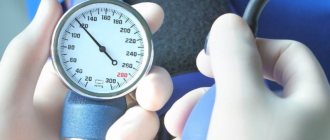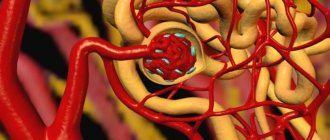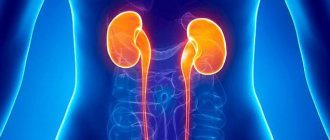Greetings, dear guests and regular readers of Alexey Shevchenko’s blog “Healthy Lifestyle”. Surely many of you have a friend who constantly complains of high blood pressure, and no medications help him. In such situations, not only patients, but even doctors themselves tend to attribute high blood pressure to violation of the prescribed regimen, dietary errors, severe stress, and so on. Meanwhile, there is another reason that causes a particular increase in blood pressure, and this reason lies in liver disease. And I want to devote today’s article to the topic “liver and high blood pressure.”
Liver condition affects blood pressure
To treat hypertension and stabilize blood pressure, modern medicine uses a rich arsenal of tools:
- calcium channel blockers;
- angiotensin receptor blockers;
- aldosterone receptor blockers;
- Alpha1 - adrenergic blockers.
These are powerful and effective tools that can normalize blood pressure in almost any case. (You can also read about high blood pressure here).
But nevertheless, there is a group of patients for whom even such a huge selection of medications does not help, and their blood pressure continues to remain unstable, periodically jumping to truly dangerous values.
Often this condition is accompanied by obesity and a disorder of brain activity: it becomes difficult for a person to remember new information, he cannot concentrate, and he is tormented by forgetfulness in everyday life. All this is a clear signal: it’s time to properly examine the liver.
It would seem, what connection could there be? After all, the liver belongs to the gastrointestinal tract, and not to the cardiovascular system. But everything in the body is interconnected, and liver pathologies are often accompanied by increased blood pressure.
What liver diseases can cause high blood pressure?
The liver is the largest gland in our body. It has a complex structure and can suffer from a large number of different diseases, both infectious and non-infectious in nature. Most often, high blood pressure is accompanied by diseases such as:
- hepatitis;
- fatty hepatosis (fatty liver);
- the presence of parasites in the body (echinococci, blood flukes, cestodiasis);
- congenital abnormalities of blood vessels;
- benign and malignant tumors;
- cholelithiasis;
- thrombosis;
- cirrhosis.
It should be noted that everything can happen exactly the opposite: first a person gets hypertension, and only then gets some kind of liver disease as a complication.
Symptoms
- Early signs of portal hypertension are pain in the right hypochondrium, nausea, flatulence, decreased appetite, emaciation, increased fatigue, yellowness of the skin and mucous membranes (especially noticeable under the tongue).
- Splenomegaly (enlarged spleen), sometimes in combination with hypersplenism, which is characterized by impaired blood clotting, decreased levels of white blood cells, red blood cells and platelets.
- Ascites (the appearance of fluid in the abdominal cavity).
- Varicose veins of the esophagus, stomach, rectum.
- Bleeding in the esophagus, which manifests itself as bloody vomiting, blood in the mouth.
- Bleeding in the stomach and intestines - the appearance of blood in the stool.
- Hepatomegaly is an enlarged liver.
- Increase in body temperature.
Portal hypertension is a common companion to liver diseases
One of the most important functions of the liver is the detoxification of dangerous substances that enter the body from the outside and are also formed as a result of digestion of food. A simplified scheme is as follows: blood in need of purification enters the liver through the portal vein, then multi-stage chemical reactions occur in the liver, neutralizing toxins present in the blood.
The portal vein is very large - its width can reach one and a half centimeters. If the liver is affected by disease, the pressure in the portal vein gradually increases, which leads to the development of so-called portal hypertension.
It should be noted that hypertension and some diseases of the cardiovascular system can also provoke an increase in pressure in the portal vein, and because of this the liver will suffer.
Damage to the liver by hepatitis viruses or toxic substances (including incorrectly selected medications) greatly disrupts the blood circulation in this organ, which can lead to the development of both portal hypertension and arterial hypertension.
Liver and blood pressure: relationship
Homeostasis in the human body is based on the coordinated work of organs and systems. The organs of the abdominal cavity and the cardiovascular system are closely related. Their mutual influence can be considered from two sides:
- Cardiovascular diseases provoke deterioration of liver function due to hypoxia and central nervous system disorders;
- Liver diseases stimulate the development or aggravate the course of CV pathologies.
Hypertension is a disease that can cause death in a patient. It has a primary and secondary form. The primary form does not have specific catalysts for its occurrence; most often it manifests itself due to changes in atmospheric pressure or hormonal imbalance.
The secondary form in most cases becomes a consequence of other pathologies. If they are treated, the person’s condition will stabilize. Sometimes hypertension develops due to improper functioning of the adrenal glands or liver.
Liver dysfunction negatively affects blood pressure. This is explained by the fact that large vessels pass through the liver through which blood circulates. If a patient has been diagnosed with liver cirrhosis, his blood pressure will always be elevated. This phenomenon is caused by the fact that scars, consisting of fibrous tissue, develop throughout the organ, which prevent its proper functioning. As a result, the vessels are compressed and blood flow in them is disrupted.
Note! Increased pressure is observed only in the portal vein. After some time, this phenomenon leads to the development of portal hypertension (PH).
How to recognize portal hypertension?
Portal hypertension is very insidious, and often does not manifest itself with any specific symptoms that would suggest a direct connection of the disease state with the liver. But if a person already has liver disease that poses a risk of developing cirrhosis, then the chance of developing a special form of high blood pressure is very high.
The complex of main characteristic symptoms of portal hypertension includes the following conditions:
- Intermittent gastrointestinal bleeding, manifested as black, tar-like stools or bloody vomit.
- Ascites is an accumulation of fluid in the abdominal cavity.
- Decreased memory, forgetfulness, the patient gets tired, his concentration is impaired.
- Blood changes: decreased platelet level.
- Susceptibility to infectious diseases, general decrease in immunity.
- Feeling of heaviness in the stomach, loud rumbling, severe flatulence.
- The vascular network becomes visible on the abdomen (the so-called head of the jellyfish)
In addition, high blood pressure may be accompanied by a number of symptoms common to this condition:
- headache and dizziness;
- attacks of nausea;
- chills or, conversely, a feeling of heat;
- facial redness.
What causes portal hypertension and how does it manifest?
This type of hypertension is characterized by an increase in pressure in the portal bed. The cause of this painful condition is poor circulation due to scarring of the liver tissue due to the presence of cirrhosis. An expansion of the connective tissue occurs, which provokes a severe spasm of the blood vessels in the head and an increase in blood pressure.
There are four known stages of this disease.
| Stage PG | Characteristic symptoms |
| First (initial) | Heaviness in the right side, painful discomfort in the peritoneum, nausea. |
| Second | Dilation of the gastric veins, enlargement of the venous lumen of the esophagus, large size of the spleen. |
| Third | The concentration of fluid in the peritoneal cavity (ascites), the liver and spleen continue to enlarge. |
| Fourth (hard) | Gastrointestinal bleeding, liver dysfunction. |
However, medicine also knows other circumstances that lead to the occurrence of hypertension with the simultaneous development of liver diseases:
- Thrombosis.
- Gallstone pathology.
- Pancreatic head cancer.
- Neoplasms of the bile duct.
But still, a significant cause of the formation of portal hypertension is pathological injury to the integrity of the liver due to the presence of cirrhosis. Portal disease can be a complication of other liver diseases:
- Hemochromatosis.
- Pericarditis.
- Schistosomiasis.
- Polycystic disease.
- Tumors.
- Fatty liver.
- Hepatitis (alcoholic).
- Hepatic fibrosis.
- Congenital anomalies.
- Damage to veins.
As you can see, the liver and the state of pressure, despite the fact that they belong to different structures of the body, are directly related to each other.
Symptoms of the disease
When the liver hurts with high blood pressure, and doctors suspect portal hypertension, you should pay attention to the manifestation of other characteristic symptoms:
- Severe migraine.
- Dizziness.
- Red complexion.
- Flashes of hot and cold.
- Increased heart rate.
- Nausea.
- Discomfort in the peritoneum.
- Loss of appetite.
- Decreased platelets.
- Flatulence.
- Concentration of fluid in the peritoneum.
- Fast fatiguability.
- Loud rumbling in the stomach.
- Decreased memory and concentration.
- The appearance of a vascular network on the abdomen.
- Systematic gastrointestinal bleeding with the manifestation of black stools or vomiting with blood.
As hypertension intensifies, its clinical signs become more intense, causing the sick person a lot of suffering.
The worsening of PH is indicated by the development of hepatorenal syndrome, which is characterized by the following symptoms:
- Perversion of taste.
- General weakness.
- Yellow tint of sclera.
- Umbilical hernia.
- Pain in the liver area.
- Deformation of fingers and toes (drumsticks).
- Curved nail shape.
- Redness of the palms.
- Increased volume of the liver and spleen.
- Dilatation of subcutaneous capillaries (stars on the body).
- Decreased volume of urine excreted (less than 0.5 l/day).
- The presence of xanthelasmas (concentration of yellow accumulations under the skin and mucous membranes).
- Severe swelling of the lower and upper extremities.
- Gynecomastia in men (enlargement of the mammary glands).
Why is this condition dangerous?
With a painful liver and hypertension, timely treatment is necessary, which will help avoid the development of extremely life-threatening complications for the patient:
- Bloody vomiting (bleeding from the esophagus).
- Black vomiting (bleeding from the gastric veins).
- Development of melena (smelly black stool).
- Hepatic encephalopathy (irreversible damage to the central nervous system).
- Bronchial aspiration (drawing in vomit and blood), which leads to suffocation due to blockage of the bronchial lumens.
- Comatose state with subsequent death.
- Kidney failure due to stagnation of blood fluid and the effects of nitrogenous toxins on the kidneys.
- General blood poisoning (sepsis), inflammation of the lungs and intestines, peritonitis.
In the absence of timely diagnosis and further therapeutic measures against PG, the risk of internal bleeding increases several times.
Methods for diagnosing portal hypertension
Most often, doctors begin to specifically examine a patient for portal hypertension if he has even a mild form of ascites (that is, the presence of free fluid in the abdominal cavity), dilated veins in the abdominal area (capita medusa), varicose veins of the lower extremities and anal area. In order to detect the disease, a variety of diagnostic methods can be used:
- laboratory blood and urine tests;
- X-ray examination;
- endoscopic examination;
- Ultrasound;
- CT or MRI.
Sometimes it becomes necessary to perform a liver biopsy. In this case, a small section of organ tissue is taken with a special needle, which is then studied in detail. This is a rather difficult diagnostic procedure, but it is very informative. With its help, the doctor can accurately determine:
- degree of liver tissue damage;
- what kind of pathological processes occur in the organ;
- is there a pathology caused by genetic factors;
- the presence of benign or malignant neoplasms.
Based on the results obtained, the doctor prescribes effective therapy.
The most popular diagnostic methods are ultrasound, CT and MRI. They are easily tolerated by patients and will not cause pain. Ultrasound and angiography are the most accessible methods. With their help, you can identify the types and size of pathology, assess the condition of the hepatic vessels, and determine the presence of worrying blood clots.
If these methods are not enough, then the doctor gives a referral for a CT scan or MRI.
A diseased liver and high blood pressure - these two problems are often closely related
Greetings, dear guests and regular readers of Alexey Shevchenko’s blog “Healthy Lifestyle”. Surely many of you have a friend who constantly complains of high blood pressure, and no medications help him.
In such situations, not only patients, but even doctors themselves tend to attribute high blood pressure to violation of the prescribed regimen, dietary errors, severe stress, and so on. Meanwhile, there is another reason that causes a particular increase in blood pressure, and this reason lies in liver disease.
And I want to devote today’s article to the topic “liver and high blood pressure.”
Liver condition affects blood pressure
To treat hypertension and stabilize blood pressure, modern medicine uses a rich arsenal of tools:
- calcium channel blockers;
- angiotensin receptor blockers;
- aldosterone receptor blockers;
- Alpha1 - adrenergic blockers.
These are powerful and effective tools that can normalize blood pressure in almost any case. (You can also read about high blood pressure here).
But nevertheless, there is a group of patients for whom even such a huge selection of medications does not help, and their blood pressure continues to remain unstable, periodically jumping to truly dangerous values.
Often this condition is accompanied by obesity and a disorder of brain activity: it becomes difficult for a person to remember new information, he cannot concentrate, and he is tormented by forgetfulness in everyday life. All this is a clear signal: it’s time to properly examine the liver.
It would seem, what connection could there be? After all, the liver belongs to the gastrointestinal tract, and not to the cardiovascular system. But everything in the body is interconnected, and liver pathologies are often accompanied by increased blood pressure.
What liver diseases can cause high blood pressure?
The liver is the largest gland in our body. It has a complex structure and can suffer from a large number of different diseases, both infectious and non-infectious in nature. Most often, high blood pressure is accompanied by diseases such as:
- hepatitis;
- fatty hepatosis (fatty liver);
- the presence of parasites in the body (echinococci, blood flukes, cestodiasis);
- congenital abnormalities of blood vessels;
- benign and malignant tumors;
- cholelithiasis;
- thrombosis;
- cirrhosis.
It should be noted that everything can happen exactly the opposite: first a person gets hypertension, and only then gets some kind of liver disease as a complication.
Portal hypertension is a common companion to liver diseases
One of the most important functions of the liver is the detoxification of dangerous substances that enter the body from the outside and are also formed as a result of digestion of food. A simplified scheme is as follows: blood in need of purification enters the liver through the portal vein, then multi-stage chemical reactions occur in the liver, neutralizing toxins present in the blood.
The portal vein is very large - its width can reach one and a half centimeters. If the liver is affected by disease, the pressure in the portal vein gradually increases, which leads to the development of so-called portal hypertension.
It should be noted that hypertension and some diseases of the cardiovascular system can also provoke an increase in pressure in the portal vein, and because of this the liver will suffer.
Damage to the liver by hepatitis viruses or toxic substances (including incorrectly selected medications) greatly disrupts the blood circulation in this organ, which can lead to the development of both portal hypertension and arterial hypertension.
How to recognize portal hypertension?
Portal hypertension is very insidious, and often does not manifest itself with any specific symptoms that would suggest a direct connection of the disease state with the liver. But if a person already has liver disease that poses a risk of developing cirrhosis, then the chance of developing a special form of high blood pressure is very high.
The complex of main characteristic symptoms of portal hypertension includes the following conditions:
- Intermittent gastrointestinal bleeding, manifested as black, tar-like stools or bloody vomit.
- Ascites is an accumulation of fluid in the abdominal cavity.
- Decreased memory, forgetfulness, the patient gets tired, his concentration is impaired.
- Blood changes: decreased platelet level.
- Susceptibility to infectious diseases, general decrease in immunity.
- Feeling of heaviness in the stomach, loud rumbling, severe flatulence.
- The vascular network becomes visible on the abdomen (the so-called head of the jellyfish)
In addition, high blood pressure may be accompanied by a number of symptoms common to this condition:
- headache and dizziness;
- attacks of nausea;
- chills or, conversely, a feeling of heat;
- facial redness.
Methods for diagnosing portal hypertension
Most often, doctors begin to specifically examine a patient for portal hypertension if he has even a mild form of ascites (that is, the presence of free fluid in the abdominal cavity), dilated veins in the abdominal area (capita medusa), varicose veins of the lower extremities and anal area. In order to detect the disease, a variety of diagnostic methods can be used:
- laboratory blood and urine tests;
- X-ray examination;
- endoscopic examination;
- Ultrasound;
- CT or MRI.
Sometimes it becomes necessary to perform a liver biopsy. In this case, a small section of organ tissue is taken with a special needle, which is then studied in detail. This is a rather difficult diagnostic procedure, but it is very informative. With its help, the doctor can accurately determine:
- degree of liver tissue damage;
- what kind of pathological processes occur in the organ;
- is there a pathology caused by genetic factors;
- the presence of benign or malignant neoplasms.
Based on the results obtained, the doctor prescribes effective therapy.
The most popular diagnostic methods are ultrasound, CT and MRI. They are easily tolerated by patients and will not cause pain. Ultrasound and angiography are the most accessible methods. With their help, you can identify the types and size of pathology, assess the condition of the hepatic vessels, and determine the presence of worrying blood clots.
If these methods are not enough, then the doctor gives a referral for a CT scan or MRI.
Surgery
If conservative therapy does not produce results and the disease continues to progress, then surgery must be called in to help.
Depending on the indications, the operation can be performed either on the heart (most often it is the installation of a pacemaker) or in the liver area (creating conditions for the outflow of blood).
If the cause of the disease is a tumor (including a benign one), then the tumor must be removed.
Transjugular intrahepatic portosystemic shunting provides good results for portal hypertension. In this case, a special mesh cylindrical structure (stent) is installed in the hepatic vein, connecting the hepatic and portal veins. This allows you to normalize blood pressure for a long period.
A similar operation is the installation of a distal splenorenal shunt, which connects the veins of the spleen and the left kidney. This allows you to reduce pressure in the dilated veins and prevent bleeding.
In the most severe cases, a liver transplant may be required.
Life style needs to be reconsidered
Every person faced with increased blood pressure caused by liver disease is interested in the question: is this condition curable? Answer: in principle, yes, but you need to prepare for a long and stubborn struggle. Unfortunately, portal hypertension is difficult to treat and requires the patient to be attentive to their health.
This means that after diagnosis, a person will have to radically change his habits.
Now for him a healthy lifestyle becomes vital, otherwise the disease will progress at a high speed and in the near future will lead to disability or a tragic outcome (for example, cirrhosis of the liver in an unfavorable development of events kills within about two years).
In order for the treatment prescribed by the doctor to produce excellent results, the patient will have to:
- quit smoking once and for all.
- Do not use alcoholic beverages under any pretext.
- Under no circumstances should you prescribe treatment for yourself, or try medications that have helped your friends well. Even the introduction of herbal remedies into the diet requires the prior approval of the attending physician.
Patients must also strictly follow the diet prescribed by the doctor. You have to especially carefully control your salt intake.
Source: https://dolgo-zivi.ru/pechen-i-povyshennoe-davlenie
Features of treatment
High blood pressure associated with liver disease requires a variety of treatments. First, high blood pressure can be either hypertension or portal hypertension - and these are different diseases that require different treatment methods. Secondly, without eliminating liver disease, it will not be possible to achieve stable normalization of blood pressure. Therefore, treatment is always comprehensive: both the liver and high blood pressure are treated.
A particular difficulty in treating portal hypertension is that the doctor needs to reduce the blood pressure in the portal vein, but not allow the pressure in the arterial system to increase.
The most commonly prescribed medications for this condition include:
- Somatostatin is an analogue of the natural hormone somatostatin, which reduces the volume of blood entering the portal vein. Like all hormonal medications, it can cause severe side effects, so this medicine should only be taken under the supervision of a doctor.
- Vasopressin is a hormonal drug that effectively lowers pressure in the portal vein, but at the same time it increases vascular tone and constricts the arterioles, which leads to increased blood pressure. Therefore, before prescribing this drug, it is necessary to carefully examine the condition of the heart.
- Beta blockers - drugs in this group are prescribed less frequently, since their effect is rather weak.
- Drugs from the nitrate group are a widely used group of drugs. One of its most popular representatives is nitroglycerin.
Liver pressure
If blood parameters in the body deteriorate, for example, it becomes thicker, this affects the liver and increased pressure occurs accordingly.
Insufficient blood supply leads to the death of hepatocytes and impaired liver function. Cirrhosis, fibrosis, etc. develop. But the opposite effect is also possible when, against the background of existing gland diseases, the pressure in the portal vein increases with the development of hypertension.
High blood pressure, like low blood pressure, together with diseases of the cleansing organ, require complex treatment.
The effect of the liver on blood pressure
In the human body, there is a connection between the cardiac system and the abdominal cavity. There are two options:
- Interruptions in the work or pathologies of the heart provoke diseases of the liver and central nervous system.
- Liver diseases provoke surges in blood pressure and cardiovascular diseases.
Improper liver function causes high blood pressure.
Stages of development of the condition in diseases of the organ:
- Hepatocytes gradually die, and the diseased gland does not have time to recover, and its function decreases.
- Along with the cells, the vessels are also damaged (they are compressed), and blood flow is disrupted.
- The pressure rises sharply in the area of the portal vein. This leads to the development of portal hypertension. Causes:
- alcoholic hepatitis;
- liver fibrosis;
- tumor;
- cirrhosis of the liver;
- enlarged spleen;
- congenital anomalies;
- pericarditis;
- thrombosis.
Mechanism of influence
Also called “portal hypertension” due to stagnation in the vein of the same name.
The most important function of cookies is considered to cleanse the blood of toxins that enter from the outside, for example, during food processing. The principle of operation of the organ is that contaminated blood enters the portal vein and is then distributed throughout the liver.
If the gland cells are affected, the process occurs slowly, which affects the blood pressure in the portal vein, namely leads to an increase. As a result, portal hypertension develops.
There are a number of diseases of the cardiovascular system that can also negatively affect the pressure in the main vein of the liver and cannot but affect the functioning of the organ.
When liver cells are damaged by hepatitis viruses, toxins, and drugs, the circulatory process is also disrupted, which entails the development of both arterial and portal hypertension.
The development of the latter develops in several stages, at the last of which extensive bleeding from dilated veins (stomach, esophagus) and against the background of liver failure are possible.
As a result, low blood pressure is observed.
Diagnostics
Portal hypertension cannot be determined with a tonometer at home. Problems with the liver can only be determined by a doctor through certain diagnostic procedures: questioning the patient, palpation and ultrasound. To determine an accurate diagnosis, you need to undergo a comprehensive examination, which includes procedures such as:
- passing OBC, OAM, biochemistry and liver tests;
- dopplerography;
- esophagography;
- fibrogastroduodenoscopy;
- sigmoidoscopy;
- venography;
- angiography.
If the disease is not detected in the early stages, bleeding occurs, which is very dangerous for health, as it greatly lowers blood pressure and leads to a hypotensive crisis.
Features of treatment
By following your doctor's recommendations, you can avoid many complications.
In order to completely get rid of the disease in the initial stages, drug treatment and the right lifestyle will be enough.
But in advanced stages, with bleeding, surgical intervention is needed.
If for some reason in the early stages it is impossible to take pills or the blood pressure needs to be brought back to normal without putting a strain on the liver, you need to resort to the help of traditional medicine.
A number of general rules for stabilizing blood pressure in case of liver damage:
- Don't eat spicy foods.
- Limit salt intake.
- There are fresh vegetables, berries and fruits.
- Avoid stress.
- Do not drink alcohol or nicotine.
- Limit TV viewing.
- Use the computer for no more than 1 hour, and then take a break.
- Use tinctures and decoctions from plants.
Treatment with medications is selected by the doctor, with an individual dosage for each patient. The following drugs are used for therapy, as shown in the table:
| Group | Indications | A drug |
| Beta blockers | To prevent heart disease | "Atenolol" |
| "Anaprilin" | ||
| ACE inhibitors | To reduce the overall tonometer readings | "Ramipril" |
| "Hartil" | ||
| "Cardipril" | ||
| Nitrates | To normalize pressure in small vessels | "Nitrosorbide" |
| Gonodatropins | To stop bleeding | "Terlipressin" |
| "Somastatin" |
Source: https://EtoPechen.ru/priznaki/drugie/pechen-i-davlenie.html
Surgery
If conservative therapy does not produce results and the disease continues to progress, then surgery must be called in to help. Depending on the indications, the operation can be performed either on the heart (most often it is the installation of a pacemaker) or in the liver area (creating conditions for the outflow of blood). If the cause of the disease is a tumor (including a benign one), then the tumor must be removed.
Transjugular intrahepatic portosystemic shunting provides good results for portal hypertension. In this case, a special mesh cylindrical structure (stent) is installed in the hepatic vein, connecting the hepatic and portal veins. This allows you to normalize blood pressure for a long period.
A similar operation is the installation of a distal splenorenal shunt, which connects the veins of the spleen and the left kidney. This allows you to reduce pressure in the dilated veins and prevent bleeding.
In the most severe cases, a liver transplant may be required.
Symptoms and development of the problem
PG is a pathological process manifested by an increase in blood pressure in the portal bed (PR). This phenomenon occurs due to circulatory problems caused by the formation of scar tissue due to cirrhosis. Connective tissue grows in the affected areas. As a result, a spasm of the intrahepatic vessels is observed, and the pressure begins to rise.
In medicine, conditional stages of PG have been identified.
| Stage | Symptoms |
| Initial | Increased blood pressure, development of pain in the abdomen, heaviness in the right side. |
| Second | Enlarged spleen, dilated esophageal and gastric veins. |
| Third | Continued enlargement of the liver and spleen, accumulation of fluid in the abdominal cavity. |
| Quarter | Development of liver failure, bleeding from the stomach and intestines. |
High blood pressure caused by liver diseases requires varied therapy. First, it should be determined that the patient has hypertension or hypertension. These diseases differ from each other and are treated in different ways. Secondly, without treatment of the liver it is impossible to bring the blood pressure back to normal. Because of such a “close” relationship between the liver and blood pressure, the patient is prescribed complex treatment.
At the initial stage of development of the disease, the doctor may prescribe conservative treatment to the patient. The most commonly used drugs are:
- Somatostatin. This hormonal agent reduces the amount of blood entering the collar vein (NV). Like any other drug in this category, Somatostatin can cause side effects, so the patient should take the medicine only as prescribed by a doctor.
- Vasopressin. A hormonal agent that can lower pressure in the veins, while simultaneously increasing vascular tone and blood pressure. To avoid complications and side effects from taking this drug, the patient should carefully examine the heart.
- Beta blockers. They are prescribed very rarely because they have a weak therapeutic effect.
- Nitrates. From this group, specialists most often prescribe nitroglycerin.
Nitroglycerin
If, after using the drugs, the patient’s blood pressure does not decrease, the doctor resorts to various vascular operations to ensure normal blood flow. If the disease is caused by the development of a neoplasm, it must be urgently removed.
In most cases, doctors resort to transjugular intrahepatic portosystemic shunting. The procedure involves installing a special mesh cylindrical structure in the venous space, which connects the hepatic and portal veins. Thanks to this, blood pressure remains normal for a long time.
In some cases, to reduce pressure, a distal splenorenal shunt may be installed, which connects the venous system of the spleen and left kidney. Thanks to this, the pressure in the dilated veins is reduced and the risk of bleeding is minimized.
At the most advanced stage, the patient may undergo a liver transplant.
ethnoscience
Traditional medicine specialists believe that it is better for the patient to treat hypertension and liver separately. In their opinion, hypertension is provoked by constant fear, anger and anger. To fix blood pressure at a normal level, it is better for the patient to change his occupation, give up bad habits and change his usual lifestyle.
Treatment of symptoms of high liver pressure involves:
- exclusion of alcohol-containing drinks;
Mandatory abstinence from alcohol
- refusal of spicy food;
- minimal consumption of salt and animal fats;
- daily consumption of vegetables, berries and fruits;
- inclusion of natural juices in the diet;
- eating nettle, dandelion leaves, turmeric, barberry, coriander, dill and lemon;
- if necessary, use natural sedatives (motherwort, mint, lemon balm, chamomile);
- daily walks in the fresh air.
It will not be superfluous to reduce your time in front of the computer and TV.
High blood pressure, pain and heaviness in the abdomen, nausea can be symptoms of portal hypertension.
Let's consider what portal hypertension (PH) is - a pathology characterized by increased blood pressure in the portal bed. The cause of the pathological condition is a violation of blood flow from the portal bed, which develops due to the growth of scar tissue in cirrhosis of the liver. In place of dead areas of parenchyma, connective tissue grows, causing the intrahepatic vessels to narrow. Blood circulation becomes difficult, blood pressure becomes higher.
| Stages of development | Symptoms |
| Elementary |
|
| 2nd |
|
| 3rd |
|
| Late |
|
There are several factors that can cause blood pressure to rise:
- neoplasms in the bile ducts;
- blood clots in blood vessels;
- neoplasm of the head of the pancreas;
- gallstones.
If the pressure has risen for no apparent reason from the heart against a background of general malaise, this may be the result of severe poisoning, including self-medication or incorrect selection of medications, or damage to the body by viral hepatitis. Hypertension is provoked by various problems with the liver, but damage to the organ parenchyma is considered the main factor. Typically, pathology is observed if the patient has hepatitis, cirrhosis, cancer, or parasite infection.
- blood pressure rises;
- the functioning of the abdominal organs is disrupted (pain, nausea, heaviness in the right side).
- the spleen enlarges;
- varicose veins of the saphenous veins of the esophagus occur (“head of the jellyfish”);
- The veins of the esophagus and stomach dilate.
- the size of the liver and spleen continues to increase;
- ascites (swelling of the abdominal cavity) develops.
- extensive bleeding from the stomach and intestines begins;
- liver failure develops.
Hypertension can develop against the background of liver disease, and the opposite effect is possible. Problems with the heart and blood circulation, accompanied by high blood pressure, can provoke damage to the gland as a target organ.
A pathology that is accompanied by an increase in pressure in the portal vein, provoked by disruptions in the venous blood flow (in the capillaries and veins of the portal pool), is called portal hypertension. This condition develops in parallel with other diseases, including pathologies of the cardiovascular system, which can provoke a persistent increase in blood pressure with the development of hypertension.
Reasons for appearance
A number of factors can provoke hypertension in combination with liver disease, the main one of which is considered to be damage to the parenchyma of the filtration organ. This condition is observed in liver pathologies of both acute and chronic nature - with hepatitis, cirrhosis, malignant neoplasms, infection with parasitic forms.
- secondary biliary cirrhosis;
- bile duct tumors;
- gallstone disease;
- tumor of the head of the pancreas;
- thrombosis;
- portal vein stenosis;
- increased pressure in the heart.
An increase in pressure in the bloodstream during liver disease can also provoke a serious condition for the patient after operations, injuries, large-scale burns, or sepsis. A pathological condition also develops due to common factors - infection of the body, bleeding occurring in the gastrointestinal tract, prolonged use of tranquilizers, and abuse of alcohol-containing drinks.
Portal hypertension is a pathology in which there is an increased effect of blood on the walls of the portal vein. Jumps in blood pressure in this case are often caused by disruptions in venous blood flow.
The pathology develops simultaneously with other diseases, including diseases of the cardiovascular system, leading to increased tonometer readings. This disease can occur due to damage to the filtration organ by the hepatitis virus and frequent use of medications. This, in turn, leads to impaired blood circulation and disruptions in the normal functioning of the human cardiovascular system.
Portal hypertension and hypertension
There are many factors that can provoke the development of hypertension and at the same time liver pathologies. These include:
- bile duct tumors;
- cholelithiasis;
- the presence of blood clots in the vessels;
- tumor of the head of the pancreas.
However, the main reason that leads to the development of the disease is damage to the liver parenchyma. This usually occurs with cirrhosis, hepatitis, infections with parasitic forms, and the development of malignant neoplasms.
Severe headaches are one of the symptoms of blood pressure
- feeling dizzy;
- hot flashes, cold flashes;
- loss of appetite, feeling of nausea, urge to vomit;
- redness of the skin on the face.
Hypertension is characterized by several stages of development with different symptoms. At the initial stage of development, mild and almost imperceptible symptoms are noted. During the next stage, the patient experiences an enlargement of the spleen, dilation of the esophageal veins, and a lack of fluid in the abdominal cavity.
The liver and blood pressure have a close relationship. With hypertension, the pressure in the portal vein increases. Etiology – impaired blood circulation in the liver due to pathological changes in tissue structure.
- Hereditary predisposition to vascular diseases.
- Bad habits – smoking and alcohol.
- Constant stress and anxiety.
- Chronic lack of sleep and overwork.
- Excess weight.
- Hormonal surges in women during menopause.
- Excessive consumption of salt and coffee.
Life style needs to be reconsidered
Every person faced with increased blood pressure caused by liver disease is interested in the question: is this condition curable? Answer: in principle, yes, but you need to prepare for a long and stubborn struggle. Unfortunately, portal hypertension is difficult to treat and requires the patient to be attentive to their health.
This means that after diagnosis, a person will have to radically change his habits. Now for him a healthy lifestyle becomes vital, otherwise the disease will progress at a high speed and in the near future will lead to disability or a tragic outcome (for example, cirrhosis of the liver in an unfavorable development of events kills within about two years).
In order for the treatment prescribed by the doctor to produce excellent results, the patient will have to:
- quit smoking once and for all.
- Do not use alcoholic beverages under any pretext.
- Under no circumstances should you prescribe treatment for yourself, or try medications that have helped your friends well. Even the introduction of herbal remedies into the diet requires the prior approval of the attending physician.
Patients must also strictly follow the diet prescribed by the doctor. You have to especially carefully control your salt intake.
And now, dear readers, I would really like to know your opinion, which you can express in the comments. I hope you liked the article and share links to it with your friends on social networks.
Link between other liver diseases and high blood pressure
Doctors know that blood pressure and the liver are interconnected.
However, portal hypertension syndrome is difficult to diagnose. Diagnosis begins with ultrasound - a hardware technique allows you to assess the condition of the liver and spleen, the structure and size of the organs. When the size increases, they speak of portal hypertension. To confirm the diagnosis, other studies are additionally carried out - biochemistry, CBC, liver tests, venography, angiography of the blood vessels of the liver, MRI, CT, Dopplerography. If necessary, the following are performed: FGSD, esophagography (examination of the esophagus).
The advanced stage of portal hypertension is determined by palpation. They also resort to techniques for measuring pressure in the portal vein, excluding other diseases that can affect the increase in blood pressure.
With hypertension, pressure readings start at 140/90 mmHg. With. The most common way to eliminate this symptom is a pill. After all, it effectively lowers it. Few people think about the consequences of frequently taking medications. As well as what causes high blood pressure:
- cardiopalmus;
- increased sweating;
- loss of clarity of vision;
- apathy;
- swelling;
- numbness of the limbs.
If you experience more than two of these symptoms, you should immediately consult a doctor. The reasons for the jumps may be:
- hormonal disorders;
- hyperplasia in men;
- blood thickening due to adrenal dysfunction;
- Atmosphere pressure;
- air temperature difference;
- ischemia;
- heart disease;
- medical supplies;
- liver dysfunction. The effect of liver dysfunction is observed in changes in the portal vein.
It is not uncommon for high blood pressure to be treated alone, without realizing that the root cause of the disease is a diseased liver.
Often patients are unaware of their diagnosis and what caused it. The liver has a very important influence on the normal functioning of the human body. With a disease such as cirrhosis, blood pressure is always higher than normal. The reasons for this relationship are that the liver tissue is scarred, causing the functioning of the organ to be impaired. This entails compression in the vessels, as a result of which the normal blood flow of the body is disrupted.
If this pathology is not detected in time, the likelihood of internal bleeding increases significantly. The phenomenon of stagnation in the patient’s body, which accompanies internal bleeding, provokes ascites. It can be diagnosed if dilated veins are visible on the skin of the abdomen, scientifically called jellyfish heads.
During hypertension, blood pressure levels begin at 140/90 mmHg. Art. Often, to get rid of this, patients take medications that help lower blood pressure. But not everyone thinks about what consequences the constant use of medications can lead to. However, as well as the fact that blood pressure with indicators above the norm:
- Increases heart rate.
- Increases sweating.
Blood pressure increases sweating
- Reduces vision clarity.
- Causes a feeling of apathy.
- Provokes swelling and numbness of the limbs.
If two or more of the above symptoms appear, it is important to immediately consult a specialist. One of the reasons for such jumps in blood pressure is a diseased liver. For example, cirrhosis always raises blood pressure. This is caused by the fact that scars appear on the tissue of the affected organ, as a result of which its functioning is disrupted and compression begins in the vessels. This leads to impaired blood flow.
Blood pressure can increase not only due to cirrhosis. Very often, PG occurs due to the presence of the following ailments in the patient:
- Intrahepatic: alcoholic hepatitis, schistosomiasis, hepatic fibrosis and polycystic disease, neoplasms, hemochromatosis;
- Subhepatic: compression (damage) of veins, enlarged spleen, genetic abnormalities;
- Extrahepatic: pericarditis, thrombosis.
Most hypertensive people know how to reduce high blood pressure and everyone has their own method that is most effective for high blood pressure. I offer you review material on various methods and methods of relieving pressure surges. Perhaps, after reading this article to the end, you will want to use another, more secure method.
What methods of reducing pressure will we consider:
- proper nutrition as a way to support the liver and lose weight
- folk remedies
- examination of the body for the presence of three diseases that can raise blood pressure (thyroid, kidneys, adrenal glands)
- breathing exercises as a way to quickly reduce pressure surges caused by stress
- learning to enjoy life (endorphin therapy)
- pharmaceutical preparations, drug treatment (review)
- vascular stenting
The previous article on hypertension examined in detail the symptoms of high blood pressure and the causes that cause high blood pressure, as well as what diseases can trigger hypertension. To get acquainted, follow the link - I know for sure that some points of the article are not known even to “experienced” hypertensive patients.
As mentioned above, our main task in case of any illness is to support the liver and help it restore normal functions, then it will gradually cope with high blood pressure. In each article I emphasize the role of the liver as our restorative system. What does the health of our liver depend on?
It is influenced by many factors, but it is changing the diet according to a person’s biorhythms that helps restore liver function after 1-2, sometimes 6 months. More details about human biorhythms and proper nutrition are described in the review article How to get rid of heartburn. Different methods and opinions.
The main thing to understand is that the liver releases filtered toxins from our body in the form of bile. And bile is released only during food intake. That is, our liver is cleansed during every meal.
Breakfast is the most important, since a fairly large and concentrated portion of bile has accumulated overnight, and in the stomach there is a maximum concentration of digestive juice from 7 to 9 o’clock. This leads to the conclusion that those who do not eat protein for breakfast, but, for example, oatmeal, are wasting high concentration digestive juice.
In the afternoon, it is best to have light snacks at 15.00 and 18.00, and at night - kefir (not low-fat, but with a fat content of at least 2.5% for better outflow of bile).
And now I will tell horror stories about what happens in our body when we don’t take care of it.
Can you imagine the harm those who don’t have breakfast at all bring to their body? All the dirt accumulated during the night remains inside all day long – you carry it around with you. How can diseases not develop here? And hypertension too...
Can you imagine how you “help” the liver when you don’t eat all day, and at night, when the enzyme system is already at a minimum, you stuff in a huge amount of food, having dinner - everything that you should eat during the day? What about diets? Especially excluding fats, because it is on them that the outflow of bile occurs? In this way, we purposefully lead our body to strokes, heart attacks and other diseases.
Do you understand where these toxins go, instead of leaving through the rectum with food? Back into the body. And they are deposited in different places, from subcutaneous adipose tissue to blood vessels. Every day there are more and more toxins. Their blood is again partially carried by current to the liver for purification, bile is formed again - and again it is not excreted in the morning with food, since we do not have breakfast.
As a result, the liver, weakened by toxins, cannot cope with the role of a healer - it simply chokes on toxins. And then we, the good ones, begin to “help” her with medicine - a synthetic aggressive drug, which she always perceives as poison. Can you imagine what will happen next? But your doctor has no idea or doesn’t want to imagine! That's how it was with my parents. They almost left me... They were treated that way. Some of you continue to “treat” this way now.
It is not uncommon for high blood pressure to be treated alone, without realizing that the root cause of the disease is a diseased liver.











